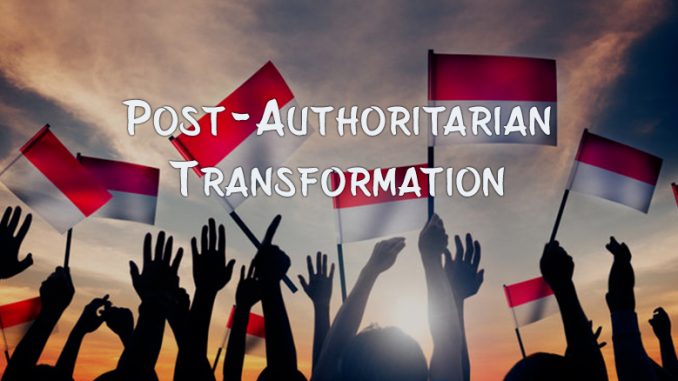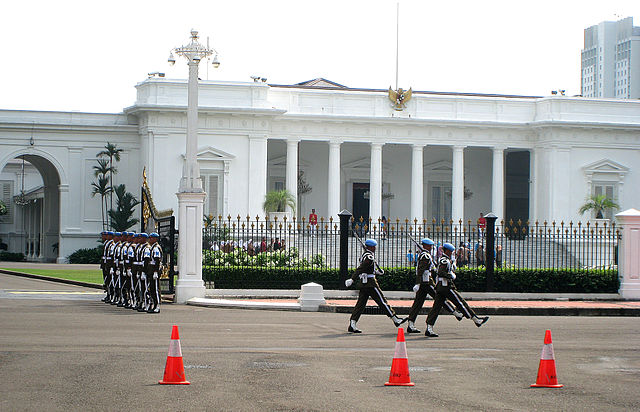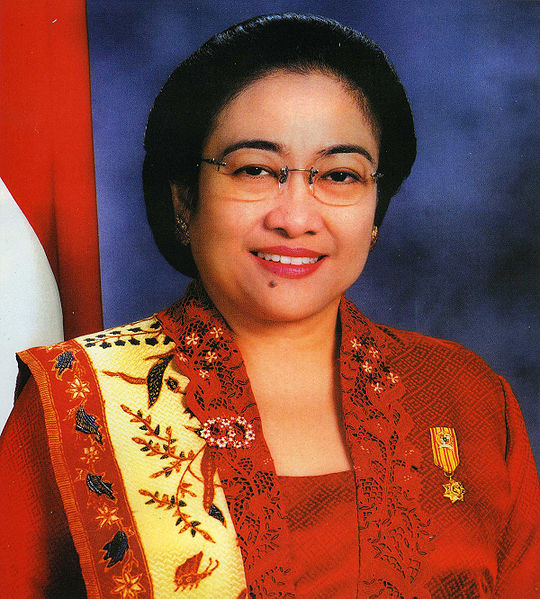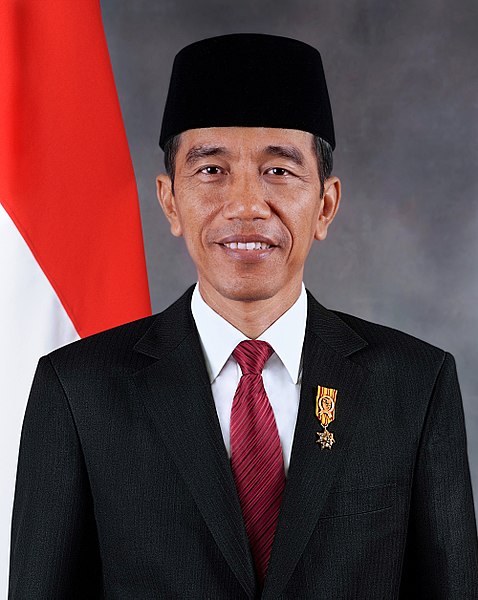
Much of the debate on post-Suharto Indonesia has focused on the question of how much has actually changed in the two decades since the end of authoritarianism in 1998. While some have suggested that powerful elites groomed under Suharto simply hijacked Indonesia’s new democratic institutions (Hadiz 2010), others have pointed to Indonesia’s increased institutional and political complexity (Tomsa 2017). In many ways, the essence of this debate is reflected in the discussion on how the role of the presidency has changed. There is a widespread consensus that post-1998 presidents have been vastly different from Suharto, but that’s where the agreement ends. How exactly, then, have Indonesian presidents ruled since Suharto’s fall, and what does that tell us about the quality of Indonesian democracy twenty years after its inception?
In this article, I argue that Suharto’s autocracy has morphed in the last two decades into a system of coalitional presidentialism in which the head of state balances the country’s main socio-political actors in a broad but internally complex alliance. Contrary to the existing coalitional presidentialism literature, I suggest that not only parliamentary parties are part of this alliance. Instead, Indonesia’s presidential coalitions include powerful actors such as the bureaucracy; the military; the police; Islamic groups; oligarchs; and local governments. Indonesian presidents, especially those coming to power after the constitutional amendments of 2002, have managed these forces within the framework of the existing post-authoritarian yet defective democracy, carefully balancing actors against each other and both rewarding loyalty and punishing dissent. This, I propose, makes these coalitions not only different from the sort of top-heavy and autocratically enforced regime alliances prevalent under Suharto, but also contrasts with Slater’s notion of presidential cartels (2018) and Tomsa’s (2017) reference to presidents being responsive to assemblies of external “strategic groups”.

Coalitional Presidentialism and Suharto’s Patrimonial “Coalitions”
In political science debates, the concept of coalitional presidentialism was developed in order to explain the stability of presidential systems operating in a multi-party landscape. Opposing traditional assumptions that multi-party presidential systems are inherently unstable, Chaisty, Cheeseman and Power (2014) found that presidents who use certain techniques of coalitional presidentialism can achieve remarkable government stability. In particular, presidents use five main tools in this regard: cabinet authority; budgetary power; partisan power over their own party; legislative power; and the exchange of favours. In this concept, the main recipients of presidential patronage are political parties represented in the legislature.
While presidential coalitionalism is conceptualised for multi-party democracies, it is important to note that even in autocracies with hegemonic party systems, presidents often have to build and sustain coalitions in order to rule effectively. In Suharto’s case, he presided over coalitions that included the military and the bureaucracy (whose representatives in the government party Golkar were categorised as “track A” and “track B”, respectively); the technocrats; other Golkar civilians (“track G”); and later, Islamic organisations. Obviously, there were fundamental differences between Suharto’s coalitions and democratic presidential alliances. For instance, Suharto’s dominant position in his hegemonic party regime was never in doubt, and his massive coercive resources effectively intimidated the members of the regime coalition into submission.
Suharto’s “coalitions” were also different in that his access to state funds and resources was personal and unmitigated. Sitting on top of a patrimonial pyramid, he handed out gifts to members of his regime coalition to ensure that they felt directly indebted to him. While Suharto perpetuated this system for around three decades, the regime coalition fell apart once the contexts that had enabled it ceased to exist. The 1997 financial crisis dried up Suharto’s patronage machine; the escalating unrest exceeded his coercive capacity; and his age and poor health had damaged his reputation as Indonesia’s undisputed leader. In May 1998, Suharto was gone.
Presidentialism in Transition: Habibie, Wahid, Megawati
Between Suharto’s fall and 2004, presidentialism in Indonesia was in transition. Suharto’s coerced patrimonial coalitions were history, but his successors struggled to find a workable democratic replacement. This was partly due to the slow process of constitutional amendments, which were negotiated from 1998 to 2002 and became fully operational only in 2004. This meant that presidents B.J. Habibie (1998-99), Abdurrahman Wahid (1999-2001) and Megawati Sukarnoputri (2001-2004) governed in an atmosphere of great uncertainty. And while they all saw the need to build coalitions to stabilise their rule, they did so under very different circumstances.
Habibie, for instance, had been catapulted into the presidency only by virtue of having been Suharto’s deputy. He lacked long-term political support from major forces, and was only able to cling to power because he initially defined himself as a transitional president. It was under this understanding that the military, political parties, Islamic organisations and the bureaucracy entered into a limited transitional alliance with Habibie, allowing him to push through a rapid democratisation program. But when he declared his intention to re-contest the presidency in 1999, the transitional coalition unravelled and Habibie was forced from power.
Habibie was replaced by Wahid, who was indirectly elected by the People’s Consultative Assembly. He was the first president to show some understanding that the new democratic context required more modern forms of coalition-building, and at least partly, he turned to the tool box of coalitional presidentialism. He forged a broad coalition of parties (and the military) to get him elected, using promises of rewards and power-sharing. But for Wahid, the necessity of presidential coalitions only extended to the creation of alliances, not their maintenance. Once elected, Wahid turned against his partners, who ultimately impeached him in July 2001. The legacy of Wahid’s removal for Indonesia’s presidential politics can’t be overstated: it convinced his successors that if they wanted to fend off the threat of impeachment, they needed to cultivate broad coalitions throughout their time in government.

Megawati, who took Wahid’s place following his impeachment, demonstrated that she had learnt some of these lessons. Broadly endorsing the concept of coalitional presidentialism, she built a multi-party alliance and maintained the line-up of her cabinet throughout her term. But two issues prevented Megawati from fully understanding and implementing the requirements of coalitional presidentialism. To begin with, in order to convince then-Vice President Megawati to replace Wahid, the vast majority of political parties and leaders had pledged not to challenge her until the end of her term. Essentially, this relieved Megawati of the delicate task of systematically anticipating impeachment threats.
Furthermore, she believed that membership in her government brought with it the obligation for personal loyalty towards her – including beyond her term. When her minister Yudyohono decided in 2004 to run against her, she took this as a personal offense. Besides reflecting her long-standing sense of entitlement, this incident highlighted her lack of appreciation that coalitional presidentialism requires constant balancing and management.
Expanded Coalitional Presidentialism: Yudhoyono and Jokowi
The year 2004 was a watershed in Indonesian politics, including for the way presidential power was exercised. Many of the constitutional amendments passed in 2002 became effective in that year, including the regulation governing direct presidential elections. This was accompanied by new rules that set the bar for presidential impeachments much higher than under Wahid. And while parliament was granted more authority too, the overall result of the amendments was a net gain for presidential power.
But somewhat counterintuitively, this is not how post-2004 presidents perceived it. Indeed, both Yudhoyono and Jokowi not only began to fully practice coalitional presidentialism, targeting parties with rewards and positions in order to protect themselves from (now much lower) impeachment threats. Going beyond this, they broadened the scope of coalitional presidentialism to situate a wide range of “strategic groups” (to use Tomsa’s term) as integral members of their alliances as well. In other words, actors such as the military; the police; Islamic groups; oligarchs; and local governments were now no longer just regime agents as under Suharto or influential interest groups as under the transitional post-Suharto governments. Rather, they obtained the same status as parties, i.e. became coalition partners of incumbent presidents.
Yudhoyono, for his part, openly conceptualised this broader definition of coalitional presidentialism. Both in interviews and in his writings, he expressed great frustration over the limitations of his presidential powers. Denying that Indonesia had a presidential system, he located the country’s polity somewhere between semi-presidential and semi-parliamentary (Aspinall, Mietzner and Tomsa 2015). Often invoking memories of Wahid’s impeachment, he suggested that Indonesian presidents needed to build broad coalitions to secure their rule. In order to avoid chaos (kegaduhan), all major forces – and not only parties – needed to be accommodated.
In practice, Yudhoyono integrated these forces into his coalition by protecting their core interests in exchange for political support. For instance, he stalled further military reform (much in contrast to Habibie, Wahid and Megawati, under whose rule major steps towards the military’s depoliticisation were taken). He also stopped a new bureaucratic reform bill after the bureaucracy had threatened a “revolution” if it passed. He gave in to the pressure of Islamic groups on positioning Muslim sects as heretic, and he further increased the influence of oligarchs on the political system by dismantling the country’s already weak public party financing system.
While Jokowi ran his 2014 campaign on a platform of abolishing such accommodationist coalitions, he ended up replicating and further consolidating them. Starting out with a minority coalition in parliament, he built a supermajority within his first two years in office by pulling previous opposition parties to his side. He further expanded the political space for the military, and after the Islamist mobilization of 2016 against the Christian-Chinese governor of Jakarta, integrated the conservative Indonesian Ulama Council (MUI) into his presidential coalition. He also sought the support from, and did not challenge the influence of, the country’s top oligarchs.

But it is crucial to emphasise that these coalitions – whether under Yudhoyono or Jokowi – are neither cartels nor associations of veto powers. Rather, they are best understood as umbrella organizations containing competing interests that are managed, balanced and moderated by the president. In this organization, no single group is in itself a veto player, defined by Tsebelis (2002) as an actor “whose agreement is necessary to change the status quo”. In Indonesia’s coalitional presidentialism, heads of state often play their coalition partners off against each other, sometimes prioritizing one actor over another; threatening to remove one actor from the coalition and include an outsider; or organizing intra-coalition majorities against the minority.
Examples of this include Jokowi’s turning to the military to counterbalance the police over his controversial cancellation of the police chief nomination in 2015; his approach to Golkar in 2016 after his own party, Megawati’s PDIP, threatened to withdraw its support for him; and his moving closer to one traditionalist Islamist party (PPP) in 2018 after another (PKB) tried to extort him by making its support conditional on its chairman being named Jokowi’s running mate for the 2019 elections.
Why, then, have Yudhoyono and Jokowi engaged in such a broadly defined coalitional presidentialism despite strengthened constitutional powers after 2004, and what does this tell us about the state of Indonesia’s democracy? Yudhoyono, for his part, has frequently pointed to Wahid’s impeachment as the fate he tried to avoid with broad coalition-building. Jokowi’s assistants, in the same vein, have recalled the shock the newly elected president felt when only a few days into his presidency Megawati and others put him under pressure over cabinet appointments. In both cases, therefore, it was the anticipation of potential threats, rather than actual and realistic impeachment scenarios, which drove them into accommodationist coalition-building.
And while this has made Indonesian democracy more stable than many of its counterparts in Asia, it has also made it stagnant and prone to regression. With so many actors given a seat at the president’s table, sectoral and group interests have acquired a disproportionate extent of influence. The irony of this is not that powerful groups have actively forced presidents into accepting a diminished role as executive moderators rather than constitutionally empowered decision-makers; it is that Indonesia’s post-2004 presidents have, thus far, surrendered their true constitutional authority to fend off threats they believe they could face, rather than those they actually confronted.
Marcus Mietzner,
Department of Political and Social Change, Coral Bell School of Asia Pacific Affairs, Australian National University, Canberra.
Bibliography
Hadiz, Vedi. 2010. Localising Power in Post-Authoritarian Indonesia: A Southeast Asia Perspective. Stanford: Stanford University Press.
Tomsa, Dirk. 2017.”Regime Resilience and Presidential Politics in Indonesia”, Contemporary Politics,” Contemporary Politics, published online ( December 2017.
Chaisty, Paul, Nic Cheeseman and and Timothy Power. 2014. “Rethinking the ‘Presidentialism’ Debate: Conceptualizing Coalitional Politics in Cross-Regional Perspective,” Democratization 21 (1): 72-94.
Tsebelis, George. 2002. Veto Players: How Political Institutions Work. Princeton: Princeton University Press.
